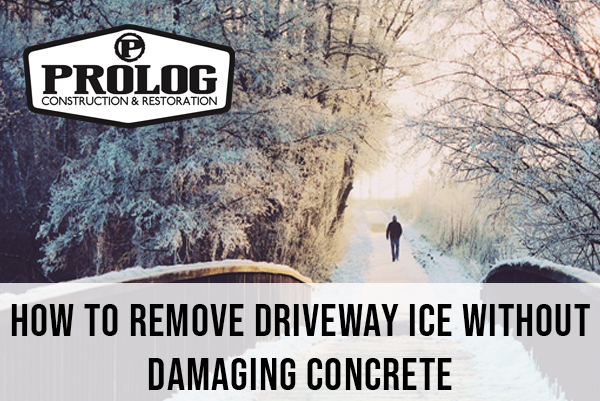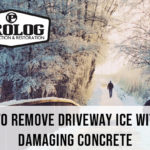When the weather outside is frightful, it can make it pretty hard to get to your log home. So how does one remove driveway ice without damaging your front concrete? Icy driveways and walkways can present a slippery problem for anyone trying to make it to your front door. While salt might be the first thing you think of, it’s not always the best solution as traditional rock salt can harm whatever it comes in contact with – concrete, asphalt, cars, shoes, and even pets’ sensitive paws.
Why does salt damages concrete?
Concrete and asphalt are highly durable, which is why they are used as driveway materials. But salt has the power to do some serious damage, especially if used regularly during winter weather as a de-icing agent. Concrete and asphalt are porous, so salt crystals are able to work their way inside where they then attract water and saturate the material. When temperatures drop below freezing, all that water inside the concrete then expands, causing cracks, fissures and other damage from the inside-out.
What do you need to remove ice from your driveway?
Remove Driveway Ice: Well, first you need to deal with the snow. If there is a layer of snow on top of the ice, always remove the snow first. No matter what de-icing solution you use, that layer of snow on top will insulate the ice and make your job so much harder. Snow shovels and snow blowers both work great.
Now for the ice. There are a few methods you can use to get rid of ice that don’t involve salt. Such as:
Sand: Spreading sand to provide extra traction on an icy driveway is an effective and safe way to keep people on their feet. Sand doesn’t melt ice, but it’s a good solution for a light to medium amount of ice on driveways, walkways or porches.
Heated driveways: If you’ve invested in a luxury log cabin home or retreat for yourself, and it’s located in an area where you know you’ll deal with ice each winter, you might want to think about heated driveways. Electric heating coils or hydronic plastic tubing are installed under poured concrete driveways and can effectively melt snow or ice. Some systems allow you to control the temperature and even heat only portions of the driveway if you want.
Snow-melting mats: Heated driveway mats are basically two large pieces of rubber with heating elements sandwiched in between. While it can be somewhat costly to invest in these if you have a rather large driveway, they work great if there is only a smaller section you need to keep ice-free such as in front of a garage and a short walkway to the front door. These plug into normal outlets, can melt several inches of ice in an hour or two, and are easily stored away during the summer.
Once you’ve removed the ice from the driveway, be sure to check around your log home for other areas where ice might cause a wipeout. Decks, side entrances or doors, covered porches and balconies can all be dangerous areas for ice to build up as well, so keep a bag of sand near for quick de-icing.
Lastly, don’t forget to look up when dealing with log homes and icy winters. Dangerous ice dams can form on the roof. If this is an issue with your log home, be sure to read our article How to prevent and remove ice dams on log homes for helpful tips and tricks.






